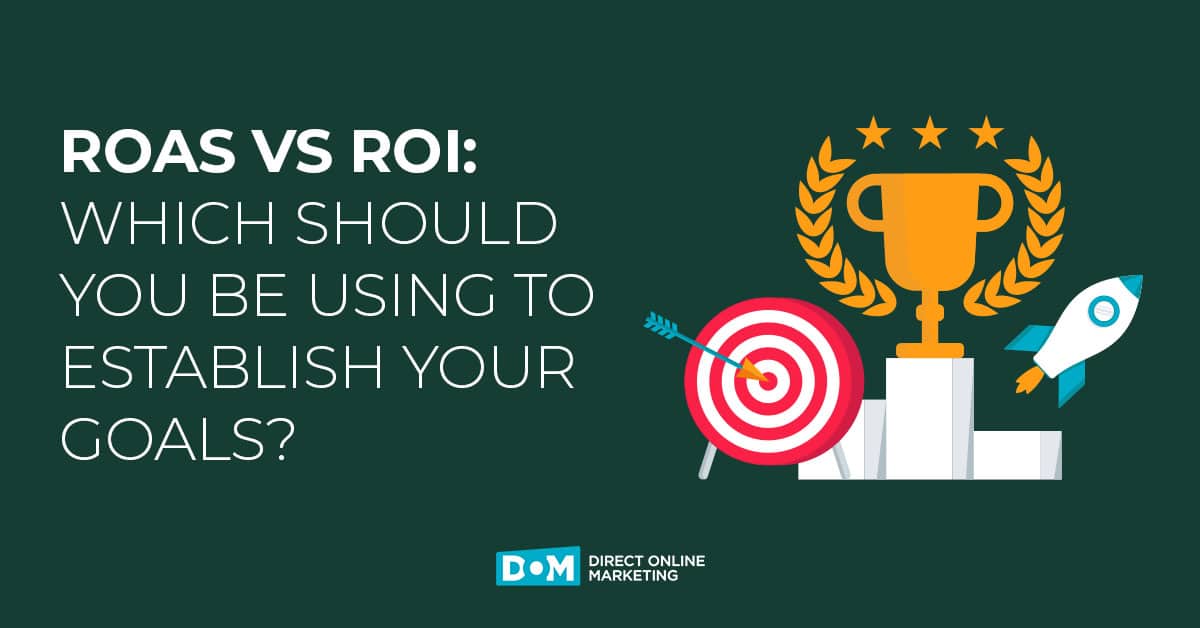
When it comes to digital advertising, there are a lot of acronyms and abbreviations that can be confusing for those who are just getting started.
We hear them incorrectly thrown around all the time, as if weekly Zoom meetings are a never ending showcase of “buzzword bingo.”
Perfect examples:
- Digital Marketing Managers who like to throw around the term geofencing when they really mean geotargeting.
- VPs of Marketing who use the acronym MQL when they really mean SQL or SAL.
When it comes to monitoring the performance of digital advertising campaigns, two of the most commonly misused acronyms we hear are ROAS vs ROI.
While these two terms are often used interchangeably, they actually mean very different things. Below, we try to bring some clarity to the disparity.
Definitions of ROAS and ROI
Before we get started, let’s make sure we have the definitions clearly stated so there isn’t any confusion.
ROI, on the other hand, stands for “return on investment” and is a measure of the overall profitability of your business. It takes into account not only advertising expenditures, but also other factors such as production costs and overhead.
What Is ROAS?
ROAS stands for “return on ad spend” and is a measure of how much revenue is generated for every dollar spent on advertising. In other words, it helps you to understand how effective your ad campaigns are in terms of generating revenue. ROAS is a marketing metric that measures how much revenue is generated for every dollar spent on advertising.
While ROAS can be a useful metric for evaluating the success of an advertising campaign, it should not be used as the sole basis for decision-making. This is because ROAS does not take into account other important factors such as brand awareness or customer lifetime value.
Nevertheless, ROAS can be a helpful tool for determining whether an advertising campaign is worth the investment.
What Is ROI?
ROI, on the other hand, stands for “return on investment” and is a measure of the overall profitability of your business. It takes into account not only advertising expenditures, but also other factors such as production costs and overhead. According to the definition provided in our own internet marketing glossary:
ROI is the key statistic for many companies that answers two questions:
- Are your advertisements generating profits?
- How much profit have you generated given the money you have had to pay?
Unless goals are explicitly stated otherwise by our clients, here at DOM we always have our eye on ROI… and in a lot of cases, you probably should too! ROI is a measure of the overall profitability of your business. It takes into account not only advertising expenditures, but also other factors such as production costs and overhead.
As a result, ROI is a more holistic metric that can give you a more complete picture of your business’s bottom line.
How Are These Two Formulas Calculated?
How To Calculate ROAS
In order to calculate ROAS, simply divide your total advertising revenue by your total advertising spend. For example, if you spend $100 on advertising and generate $1,000 in revenue, your ROAS would be 10.
Our Director of Client Success Janice Masters offers a lot of insight on calculating ROAS in this blog post – What Is ROAS? How is It Calculated?
How To Calculate ROI
Any business owner knows that it’s important to measure the return on investment (ROI) of any marketing campaign or product.
But what is the best way to measure ROI? There are a number of different methods, but each has its own advantages and disadvantages.
One popular method is to simply compare the revenue generated by the campaign or product to the costs incurred. This can be a quick and easy way to get an idea of whether or not a campaign is successful, but it doesn’t give a complete picture.
Another common method is to calculate the lifetime value of a customer. This takes into account not only the revenue generated by the initial sale, but also any repeat business or referrals. This can be a more accurate way to measure ROI, but it can be time-consuming to calculate.
Ultimately, there is no single “best” way to measure ROI. The best approach depends on the specific situation and goals of the business.
How Do ROAS And ROI Differ From One Another?
Now that you have a good foundation for how these two metrics are defined and calculated, you may
ROAS Is Only Applicable To Your Ad Spend
While ROAS can be a useful metric for evaluating the success of an advertising campaign, it should not be used as the sole basis for decision-making.
This is because ROAS does not take into account other important factors such as brand awareness or customer lifetime value.
When you are trying to debating between using ROAS vs ROI, it’s important to also know that brand awareness is hard to apply to ROI, also.
ROI Takes Factors Into Consideration Your Marketing Team Doesn’t Control
There are a number of factors that can affect your ROI, including the cost of goods sold, overhead expenses, and marketing costs.
To improve your ROI, you need to find ways to reduce these costs while still maintaining or increasing sales.
How can you accomplish this?
- One way to do this is to streamline your operations and cut waste.
- Another is to invest in effective marketing tools that will help you reach more customers without breaking the bank.
By taking steps to improve your ROI, you can ensure that your business is as profitable as possible. In comparing ROAS vs ROI, ROAS may be a better metric for whoever is responsible for managing your ads… however, it won’t be a high value metric for measuring whether or not your business is successful.
Which Calculation Is Best For Analyzing Campaign Performance?
When choosing between ROAS and ROI, it’s important to consider which metric is more relevant to your specific goals. Any business owner knows that a strong ROI is essential for success, and we would be very shortsighted to make a statement like “ROI doesn’t matter.”
Of course your ROI calculation matters. But for your digital advertising campaigns, there are a lot of factors that go into calculating your ROI that can’t be controlled by an outside agency supporting your advertising efforts or an in-house marketer managing your campaigns.
Because of those factors that they can’t control, you may find it to be a more effective measurement of your campaign performance if you look at ROAS over ROI.
So, to make this comparison as simple as possible:
- Are you primarily concerned with generating revenue from your ads? If yes, then ROAS is the more appropriate metric.
- Are you’re interested in understanding the overall profitability of your business? If yes, then ROI is the better choice.
Closing Thoughts On Using ROAS vs ROI For Your Digital Advertising
Have you ever asked your digital advertising agency what the ROI is of your campaign?
Did they struggle to give you an actual answer?
If they did, it’s probably because there are a lot of variables they aren’t able to account for in their performance calculations.
Unless you have full transparency with your agency, they aren’t going to be able to tell you what your operating expenses are or factor in lifetime values of the customers you acquire.
Because they don’t have visibility into those short-term costs or long-term profits, you may find it more value to track their performance against a ROAS goal.
ROAS is an important metric to consider when measuring the success of your advertising efforts – but it is often overlooked in favor of ROI. When you calculate and track ROAS performance, you can determine whether or not you are getting a good return on your investment in advertising.
There are many ways to improve both ROAS and ROI, and we have discussed some of them above.
As you move forward with your advertising campaigns in the future, it will be better for you to have a clear understanding of which metric you actually want your agency to benchmark their performance against. That way, the likelihood that they meet or exceed your goals should improve.
Unsure if the ROAS or ROI of your marketing campaigns is competitive? You may want to contact our digital marketing strategists for an evaluation today.





